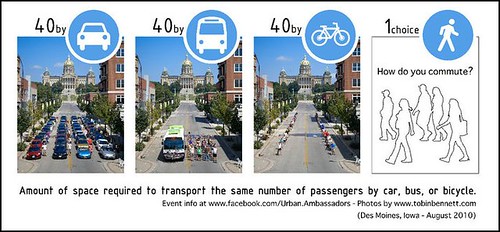Davis California needs to legalize the Idaho Stop (bicycling)
A notebook for sale at World Market.
Davis, California, until Portland, Oregon somewhat superceded it, was the nation's leading bike city. This transpired because when the University of California Davis was founded in the early 1960s, the campus mobility network was designed to be car free--it has since changed. At the time, the US was in the heyday of bicycling familiarity, so students took to the bike for their primary means for getting around. (There is a chapter on Davis in the book Pedaling Revolution by Jeff Mapes, and a master's thesis by Theodore Buehler, on the city's bicycling history, Fifty years of bicycle policy in Davis, CA).
The Idaho Stop is a pro-bike vehicular policy that is followed by many bicyclists, but is only legal in the State of Idaho. It allows bicyclists to treat stop signs as yields and traffic signals as stop signs--provided there is no oncoming traffic or significant breaks in traffic.
According to the Sacramento Bee, in "Davis adopts new bicycle fines after public backlash," Davis police officers hadn't been citing bicyclists running stop signs, because the fines are so high--they were $202 per infraction--and they thought that students would be hard pressed to pay. From the article:
Students at UC Davis, which has an estimated 20,000 bicycles on campus, have long considered fines too severe, at least for those who get caught. To encourage hesitant bicycle officers to enforce road rules, the Davis City Council took a counterintuitive tack last week by voting unanimously to reduce fines for bicycle infractions immediately. The new tiered bicycle fine system imposes a less-severe $50 fee on first-time offenders.While a city within California can't adopt a policy not sanctioned within the State Motor Vehicle Code, a jurisdiction could petition for a change in the code to allow for differentiated practices. Although the likelihood of it passing would be minimal, according to commentary linked in this SF Bicycle Coalition webpage--although I think it would have a better chance were the initiative to come from university towns, rather than from San Francisco.
For a variety of reasons, it makes sense to not expect bicyclists to follow the same rules as cars, just as early regulations on motor vehicles--such as requiring a flagman to walk ahead of moving cars, to warn pedestrians--were a somewhat unreasonable restriction on cars.
Note that according to the National Household Travel Survey, 21% of US household trips are one mile or less; 30% of trips are 1-3 miles; and 13% of trips are 3-5 miles. So 64% of trips are 5 miles or less.
The girl crossing Pennsylvania Avenue SE on her way to school is riding a bike with training wheels. I wasn't fast enough to take a photo of a woman walking her dog and running alongside her son biking to school.
In the city, bicycles are competitive with cars for trips of up to 5 miles--which take a bike about 30 minutes. Bikes have the advantage when you take into account finding parking, parking, and getting from a car to your final destination.
But part of the advantage comes from being able to "run" stop signs and lights, to make up some of the time.
If you want to reduce the number of car trips in your city--cars take a lot more space than bikes--than you have to leverage the advantages of alternative modes to the car, rather than cripple the potential advantages that alternatives offer.

Labels: bicycling, law and the legal process, sustainable transportation, transportation planning, urban design/placemaking





6 Comments:
UC Davis was founded many years - 40-60 years - before the 1960's.
I could have been more detailed. Just as UCSF was part of Berkeley originally I think, what is now UCD started as the Ag Station for UCB.
It split off into its own separate university structure, distinct from Berkeley, in 1959. I was discussing to the first campus plan following the designation of UCD as a distinct UC campus not under the control of UCB.
Running lights saves time. Running stop signs -- not so much. It makes it easier -- starting up from a bike is pretty hard but not much faster.
In many cases with stop signs, if bikes are running them it is an indication that the stop sign is overkill. Or just needed at peak times for cars.
5 miles is a bit of a stretch. I find (stopping at lights) that 2 miles is about the same as a car, but after that it is more efficient to drive.
Try driving through Columbia Heights or on various streets at certain times of day. Biking is faster. But yes, hills etc. change the calculation.
But driving isn't faster if you don't own a car... and if you can't rely on a place to park.
... what I mean is depending on where you are, it's pretty typical to run into significant bottlenecks between your origin and your final destination. E.g., I could drive (if I had a car) down Georgia Avenue to Downtown, but the intersection at U Street (because of left turning traffic and the failure to eliminate some parking spaces on the southbound side of the street) traffic backs up for a couple blocks many times of day, abetted by large buses, trucks, etc.
I can get through such a bottleneck on my bike very very quickly. Not so in a motor vehicle.
But as always, very good point about stop sign vs. traffic signal, although the reason you have them is to mediate between pedestrians and cars in walkable residential districts.
The University of California Davis fee structure is described here. The fee structure depends upon the course that you are pursuing. For instance, an MBA is Rs. 34, 00, 000/- and that of BCA is Rs. 40, 00, 00/-. To know more about it, kindly go through theory.
Post a Comment
<< Home